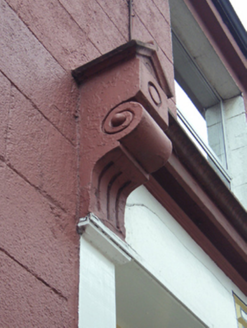Survey Data
Reg No
15603176
Rating
Regional
Categories of Special Interest
Architectural, Artistic
Previous Name
Star Mineral Waters
Original Use
Factory
In Use As
Office
Date
1876 - 1886
Coordinates
297479, 140084
Date Recorded
13/06/2005
Date Updated
--/--/--
Description
Terraced four-bay two-storey factory, extant 1886, on a rectangular plan with shopfront to ground floor. Burnt, 1959. Renovated, ----, to accommodate continued alternative use. Replacement pitched artificial slate roof with ridge tiles, rendered chimney stacks having stringcourses below corbelled stepped capping, and uPVC rainwater goods on rendered eaves. Rendered, ruled and lined wall to front (east) elevation on rendered chamfered plinth. Rendered shopfront to ground floor on a symmetrical plan. Square-headed window openings (first floor) with cut-granite sills, and concealed dressings framing replacement aluminium casement windows replacing one-over-one or two-over-two timber sash windows. Street fronted with concrete footprint to front.
Appraisal
A factory erected by James Donohoe (1845-1916), proprietor of the Star Mineral Water Factory (established 1876), representing an important component of the later nineteenth-century industrial heritage of Enniscorthy with the architectural value of the composition confirmed by such attributes as the compact rectilinear plan form; and the diminishing in scale of the openings on each floor producing a graduated visual impression. Having been well maintained, the elementary form and massing survive intact together with quantities of the original fabric including a symmetrically-composed shopfront of artistic interest making a pleasing visual statement in Templeshannon at street level. NOTE: The factory was described (1885) by George Henry Bassett as 'a well equipped building…[containing] the machinery which includes the best appliances of modern invention for this particular branch of industry. The floor is flagged, and the limewashed walls are maintained in snowy whiteness. It would be difficult to find a place showing stronger evidence of the preference of the proprietor for perfect sanitary arrangements' (Bassett 1885, 289).



